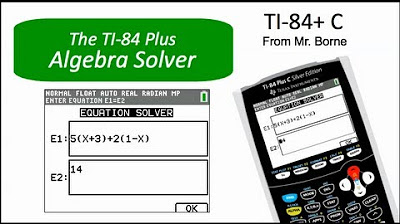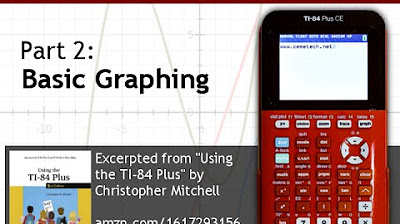We Need To Talk About Calculators
TLDRThis video explores the intriguing popularity of the TI-84 Plus Silver Edition calculator among calculus students, not for its advanced features, but rather for its lack of a Computer Algebra System (CAS). This characteristic made it a favorite in academic settings, as it requires students to manually solve calculus problems, thereby promoting understanding over mere computation. The speaker reflects on the broader debate over the role of calculators in education, advocating for their use with the stipulation that students must demonstrate their work process. The transition to the TI-84 Plus CE, a color version without CAS, signifies a continuation of this educational philosophy, underscoring a unique phenomenon where a device's popularity stems from its limitations rather than its capabilities.
Takeaways
- 💻 The TI-84 Plus Silver Edition has been one of the most popular calculators worldwide, especially among calculus students.
- 🔢 Its popularity is not just due to its functionality as a reliable calculator, but because it lacks a Computer Algebra System (CAS).
- 📊 The lack of CAS makes it favored in educational settings where manual problem solving is preferred.
- 📱 The TI-84 Plus CE is a newer, color version that continues the legacy without a CAS, maintaining its acceptance in classrooms.
- 📚 Teachers often prefer calculators like the TI-84 because they require students to demonstrate the step-by-step process of solving problems.
- 👨🎓 Personal anecdote from the speaker highlights the value of showing work in mathematical calculations to differentiate between human and calculator-generated solutions.
- 🖥 Other calculators like the TI-92 and TI-89 have CAS capabilities and can perform calculus operations automatically.
- 📖 There's ongoing debate on the use of calculators in education, balancing between technological aid and mental calculation skills.
- 🤔 The story shared about prohibitions on calculator use in advanced physics courses illustrates the tension between manual calculation skills and the reliance on technology.
- 🚀 The speaker advocates for the pragmatic use of calculators in education, emphasizing the importance of understanding and showing the mathematical process.
Q & A
Why has the TI-84 Plus Silver Edition been popular among calculus students?
-The TI-84 Plus Silver Edition has been popular among calculus students not because of its advanced features, but rather because it lacks a Computer Algebra System (CAS), which prevents it from automatically solving calculus problems such as derivatives and integrals. This limitation made it a preferred choice for educational settings where understanding the process is valued over simply obtaining the answer.
What is a Computer Algebra System (CAS) and why is its absence significant in calculators for educational use?
-A Computer Algebra System (CAS) is a software feature that allows calculators to perform symbolic mathematics, such as automatically solving equations, derivatives, and integrals. Its absence in calculators like the TI-84 Plus is significant for educational use because it requires students to understand and manually solve problems, rather than relying on the calculator to do it for them.
What calculator replaced the TI-84 Plus Silver Edition, and what are its notable features?
-The TI-84 Plus CE replaced the TI-84 Plus Silver Edition. Notable features of the TI-84 Plus CE include a color display and a slimmer, more modern design, making it a more appealing and functional option for students.
How do educators typically view the use of calculators in calculus classes?
-Educators typically have mixed views on the use of calculators in calculus classes. While some allow any calculator as long as students show their work, others prefer calculators that do not have CAS to ensure students learn and understand the mathematical processes rather than relying on technology to solve problems for them.
What is the impact of calculators on learning mathematics according to the script?
-According to the script, calculators can be a valuable learning tool when used appropriately. They should complement the learning process, with an emphasis on understanding and performing calculations manually when possible, to develop mathematical thinking and problem-solving skills.
What is the stance of the video's narrator on the use of calculators in education?
-The video's narrator believes that calculators should be allowed in education as a tool to aid learning. However, they emphasize the importance of students showing their work for calculations to demonstrate understanding and to distinguish between work done by a human versus a calculator.
Can you name calculators that include a Computer Algebra System?
-Calculators that include a Computer Algebra System (CAS) mentioned in the script are the TI-92 and TI-89, which are capable of performing calculus operations automatically.
What does the script suggest about the evolution of technology and its acceptance in educational contexts?
-The script suggests that while technological advancement generally leads to devices with more features being preferred, in the context of educational calculators, simpler devices without CAS have been historically favored to encourage learning and understanding over convenience.
How does the script illustrate the importance of mental calculation in mathematics?
-The script illustrates the importance of mental calculation by referencing the movie 'The Man Who Knew Infinity' and highlighting how mathematicians in the past performed complex calculations without calculators, suggesting that there is value in developing the ability to calculate mentally.
What is the script's perspective on technology's role in education, particularly with calculators?
-The script's perspective is that technology, including calculators, should be embraced in education as tools that can aid learning. However, it emphasizes the importance of balancing technological use with the development of fundamental mathematical skills and understanding.
Outlines
🧮 The Surprising Popularity of the TI-84 Plus
The TI-84 Plus Silver Edition, long celebrated as a preferred calculator for calculus students, owes its popularity not to its comprehensive features but surprisingly to its limitations. The key to its appeal is the absence of a Computer Algebra System (CAS), which precludes the calculator from solving calculus problems automatically. This limitation made it a favored choice among educators who required students to understand and manually solve calculus problems, ensuring that the learning process remained rigorous. The narrative further explores the evolution of calculators within educational settings, juxtaposing teacher and student perspectives on the use of such devices in learning environments. The introduction of the TI-84 Plus CE, a color version with improved features yet still lacking CAS, represents the ongoing balance between technological assistance and educational integrity in mathematics education.
📚 The Great Calculator Debate and Educational Perspectives
The discourse extends into a broader reflection on the role of calculators in education, embodying personal teaching experiences and the perennial debate over their usage in classrooms. Advocating for a balanced approach, the speaker supports the use of calculators as long as students demonstrate their understanding by showing their work. Highlighting the historical context, the script touches upon the intrinsic value of mental calculation through an anecdote from the film 'The Man Who Knew Infinity,' which celebrates the mathematical genius of Ramanujan. This narrative reinforces the argument for fostering mental arithmetic skills alongside the judicious use of technological tools like calculators. The discussion underscores a nuanced perspective that while calculators are beneficial for enhancing learning, they should not supplant fundamental mathematical reasoning and problem-solving skills.
Mindmap
Keywords
💡TI-84 Plus Silver Edition
💡CAS (Computer Algebra System)
💡TI-84 Plus CE
💡Derivatives and Integrals
💡Educational Philosophy
💡Mental Calculation
💡Calculator Debate
💡Show Your Work
💡Technology in Education
💡TI-92 and TI-89
Highlights
The TI-84 Plus Silver Edition is one of the most popular calculators worldwide, especially among calculus students.
Its popularity isn't due to its features, but rather because it lacks a Computer Algebra System (CAS).
The absence of CAS makes it favored by educators for teaching calculus without enabling shortcuts for solving problems.
The TI-84 Plus CE, a color and upgraded version, is recommended for its balance of functionality and restrictions.
Calculators like the TI-92 and TI-89, which have CAS, can solve calculus problems directly.
The debate on calculator use in classrooms revolves around balancing technology benefits with the need for learning fundamentals.
Some educators insist on manual calculations to encourage mental computation skills.
Real-life examples highlight both the necessity and the limitation of relying on calculators for learning.
Anecdotes from physics and pre-algebra contexts underline the diverse opinions on calculator usage in education.
The importance of showing work in calculations to demonstrate understanding, despite calculator use.
The philosophical and educational considerations behind calculator policies in classrooms.
The story emphasizes the ongoing debate and varied opinions on the role of calculators in mathematics education.
Encouragement to engage with mathematics actively, with or without calculators, highlighting the tool's value and limitations.
The phenomenon of technology being popular for its limitations rather than its capabilities, as illustrated by the TI-84.
The narrative concludes with a call to embrace calculators as tools for learning while ensuring fundamental skills are not overlooked.
Transcripts
Browse More Related Video

Which TI-84 Plus is Best for You? Reviewing Every TI-84 Plus (CE)!

How to Put Notes on the TI 84 Plus CE!

How to use the Algebra Solver on the TI-84 Plus

Using Your TI-84 Plus CE Part 2: Basic Graphing

How to Solve Systems of Equations on TI-84 Plus CE and TI-84 Plus Silver Edition

TOP 5 Best Scientific Calculator [ 2024 Buyer's Guide ]
5.0 / 5 (0 votes)
Thanks for rating: